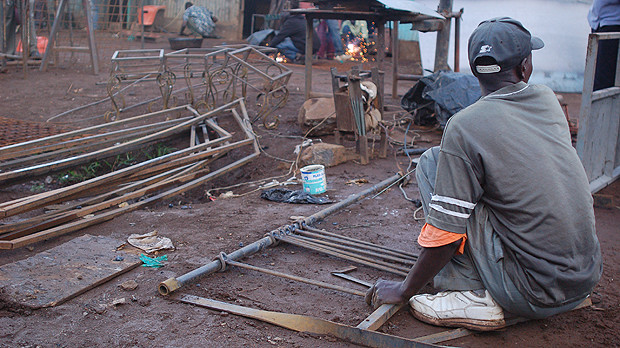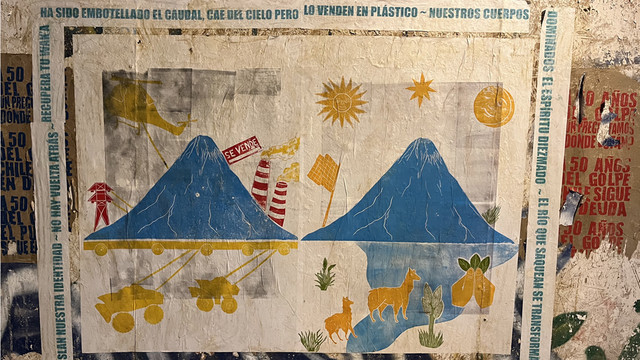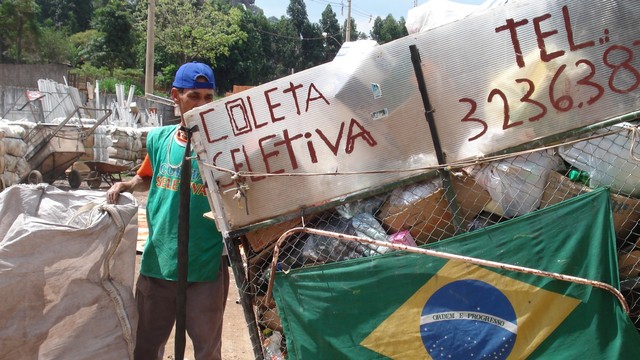Lessons from the informal sector
Could the informal economy provide the way forward for the green growth agenda? Ahead of an IIED event on 25 February, Mao Amis looks at lessons that can be learned.


A welder uses home-made equpiment in Kenya, where the Jua Kali (informal economy) thrives and can solve any problem (Photo: Erik (HASH) Hersman, Creative Commons, via Flickr)
It's a well-documented fact that the informal sector is key in many developing countries, accounting for most employment opportunities, delivering a full range of services and providing social cohesion. In Kenya, for example, the informal economy is referred to as Jua Kali in Swahili, which loosely translates to the ability to solve any problem.
But can it also provide useful lessons for delivering green growth?
In Kenya's thriving informal sector, all needs are catered for. If you have a bad hair day, a salon is just a few steps away. If your car is broken down? No problem, there is a roadside mechanic. And who needs a supermarket when you can pick your fresh vegetables from the Mboga (vegetable) lady in front of your housing estate?
It's no surprise that 2.5 million people in Nairobi are employed in the sector. In South Africa the sector contributes between South African Rand 150- 300 billion (around US$10-20 billion) to the country's gross domestic product.
Indeed the informal economy is so intricately connected with people's daily lives, it boggles the mind when we attempt to box it in as the 'other' sector. If we are to achieve the green growth agenda, it makes sense to look to the informal sector as a starting point.
Lessons from the informal sector
In the last couple of years significant strides have been achieved in driving the green growth agenda, with various strategies and action plans at country level. The real challenge is how to translate all those policies and strategies into action.
In that regard the informal sector offers many lessons that we could all learn from in driving the transition to a green economy:
- Collaboration is the currency of the informal economy. Informal traders often have to collaborate with their competitors in order to forge ahead, whether its through pooling resources to bulk order goods, or helping to staff each other's stores, they value building coalitions and social capital. If the protracted climate change negotiations are anything to go by, we could learn a few things from the informal sector in how to close a deal.
- The sectors where informal actors are most active, such as manufacturing, agriculture, construction and transport, are also the key sectors that are vital for driving the green growth agenda. Due to the creativity and flexibility in the sector, it presents an excellent opportunity to test new business models that more inclusive, and that can be applied in the mainstream economy
- The informal sector mostly employs young people, a key demographic in charting the transition to a green economy. The green growth agenda can learn a lot from models of youth engagement, and how to inspire a generation. Youth in the informal sector are also the future business leaders, community organisers and politicians whose buy-in will be key to achieving the green growth agenda, and
- In the agricultural sector, many smallholder farmers have been implementing sustainable agriculture practices for millennia. There is an opportunity to tap into those practices to promote climate smart agriculture. The current top down approach to driving the green growth agenda has stifled local involvement, resulting in farmers questioning the tools and practices being forward to promote sustainable agriculture.
The thriving nature of informal enterprise in developing countries provides clear potential for promoting green growth. In South Africa estimates suggest there are on average 10 enterprises per square kilometre in the townships; while Uganda was voted as the most entrepreneurial country in the world in 2015.
Indeed, I would argue that the informal economy should be seen as providing solutions to many of our problems, a place where anything and everything can be fixed, including our planet if need be.
Mao Amis (mao@africege.org) is the founder and executive director of the African Centre for Green Economy (AfriCGE) and will be presenting at IIED's conference on "The biggest 'private sector': What place for the informal economy in green and
inclusive growth?"


